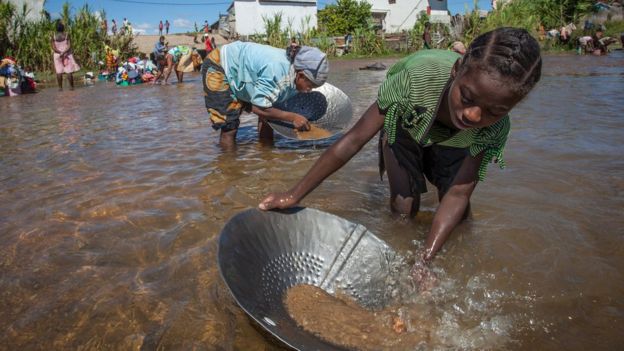
‘Sapphire rush’ threatens rainforests of Madagascar
The influx of thousands of gem hunters is disfiguring a protected environment and prompting calls for military intervention.
Source: www.theguardian.com
Photo: (www.bbc.com/news/)

A “sapphire rush” has brought tens of thousands of people into the remote rainforests of eastern Madagascar, disfiguring a protected environmental area and prompting calls for military intervention.
More high-quality sapphires have been found in the biodiverse area known as Corridor Ankeniheny-Zahamena in the past six months than were found in the entire country over the past 20 years, according to Vincent Pardieu, a French gemologist who has been visiting mines there for more than a decade.
“I can tell you this is big,” Pardieu said. Gem trade shows around the world now have “nice, big, super-clean sapphires” from the region. “It’s the most important discovery in Madagascar for the past 20 or 30 years.”
Tens of thousands of miners and gem traders have poured into the rainforests around the village of Bemainty, said local officials. The miners have cut down thousands of acres of forest in the protected area, which environmental group Conservation International helps to manage, said the officials.
The island nation is renowned for its biodiversity, and the protected forests in the eastern corridor are one of Madagascar’s most precious resources, according to the World Bank. The corridor is home to more than 2,000 plant species found nowhere else on earth, and 14 endangered species of lemur, according to the environment ministry.
With local officials unable to control the situation, Conservation International has called for a military intervention. “We have made many requests to the government to call the army,” said Bruno Rajaspera, the group’s director of projects. “But there are too many influential people that are involved in the trade of the stones. The government doesn’t dare take concrete action.”
The prime minister’s office did not respond to requests for comment.
Madagascar produces about half of the world’s high-end sapphires, according to Michael Arnstein, the president of the Natural Sapphire Company, a US-based gemstone business.
Arnstein, who has been visiting the country for two decades, said about 70% of its sapphire market was controlled by Sri Lankans, who smuggle the gems back to their country to be cut and exported for sale. About $150m worth (£120m) of sapphires might leave Madagascar every year, though the exact figure is impossible to know as the industry is not well regulated, he said.
“You have all these small-scale, wild west operations,” he said. “Everything’s pretty much illegal. There’s no oversight, no taxes. It’s chaos.”
The latest rush for sapphires began about six months ago, leading Madagascar’s government to hold meetings in November and declare the corridor’s protection a national priority.
Environmentalists hoped the government would send in the army, as it did during a smaller rush in 2012 after gems were first discovered in the area. At the time, the government arrested and deported several Sri Lankan traders.
The gem traders bring labourers from other parts of Madagascar to the corridor, Rajaspera said. The workers carry in food and equipment by hand, trekking at least five hours through the jungle to reach the mining sites, which are inaccessible by car or motorcycle.
As more and more miners entered the area, Conservation International tried to help maintain security by paying police forces, but it said the situation remained out of control. By October, the population at the main mining site was growing by about 1,500 to 2,000 people a day, according to Rosey Perkins, a British gemologist who was there at the time.
People carried rice, chickens and even goats out to the mining sites. The main site “looked quite wild”, Perkins said. “It was a real surprise to see a whole field of humanity out in the wilderness.”
Many residents of the Didy area that includes Bemainty and surrounding villages also want the national government to take action, according to Didy’s mayor, Davidson Radoka. Only a small percentage of locals profit from the mines, he said. Some schools have had staffing issues as teachers have left to try their hand at mining. As demand for goods has increased, the prices of staples such as rice have risen by 50% or more.
Above all, people worry about their safety.
“Security is a very, very, very serious problem right now,” Radoka said. Bandits are often out at night, and eight people have been murdered in the area since 21 December, he said.
Despite the dangers, aspiring miners keep coming. Two years of drought in many parts of Madagascar have led farmers to seek out alternative sources of income.
“You have a lot of people who are employed. Without this discovery, they would be in serious trouble,” Pardieu said. “That’s why the authorities are not doing anything. They are letting people mine. They don’t want to have 20,000 people starving in town, with no money.”
Local officials believe the number of miners in the Bemainty area may be as high as 200,000. Officials say they worry that if the mining remains uncontrolled, it could spread. In November, a group of about 500 miners went deeper into the protected area to search for gemstones.
“They arrived suddenly, and we saw that this could be a big problem for our area,” said Nestor Rafenonirina, the director of the northernmost park in the corridor.
His agency, Madagascar National Parks, used a police brigade to remove the miners. But if their numbers grew, such action would be harder to take, he said.
Pardieu said he expects many more sapphire and ruby mines to be discovered in the protected area over the next five to 10 years: “There is just one deposit after another.”
